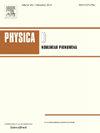Influence of extreme events modeled by Lévy flight on Atlantic meridional overturning circulation stability
IF 2.9
3区 数学
Q1 MATHEMATICS, APPLIED
引用次数: 0
Abstract
How will extreme events due to human activities and climate change affect the Atlantic meridional overturning circulation (AMOC) is a key concern in climate predictions. The stability of the thermohaline circulation with respect to extreme events, such as fresh-water oscillations, is examined using a conceptual stochastic Stommel two-compartment model. The extreme fluctuations are modeled by symmetric -stable Lévy motions whose pathways are cádlág functions with at most a countable number of jumps. The mean first passage time, escape probability and stochastic basin of attraction are used to perform the stability analysis of on (off) equilibrium states. Our aim is to elucidate the interplay between fresh-water forcing, , and the stability of metastable AMOC states. Our results argue that for a model with weak fresh-water forcing strength, the greatest threat to the stability of the on-state represents noise with low jumps and higher frequency (modeled by small values of ) that can be seen as fresh-water inputs from glacier melting due to ocean warming caused by increased greenhouse gas emissions. On the other hand, the off-state stability is more vulnerable to agitations with moderate jumps (modeled by moderate values of ) and frequencies that can be interpreted as a possible scenario of recovery of the Atlantic thermohaline circulation. Under the repercussion of stochastic noise, on to off transitions are more expected in the model with the strong fresh-water influx. Moreover, transitions from one metastable state to another are equiprobable when the fresh-water input induces a symmetric potential well.
lsamvy飞行模拟的极端事件对大西洋经向翻转环流稳定性的影响
人类活动和气候变化导致的极端事件如何影响大西洋经向翻转环流(AMOC)是气候预测中的一个关键问题。温盐环流相对于极端事件(如淡水振荡)的稳定性,使用概念随机Stommel双室模型进行了检验。极端波动由对称α-稳定lsamvy运动来模拟,其路径是cádlág函数,最多有可数的跳跃次数。利用平均首次通过时间、逃逸概率和随机吸引力盆地对开(关)平衡状态进行了稳定性分析。我们的目的是阐明淡水强迫、α和亚稳AMOC态稳定性之间的相互作用。我们的研究结果表明,对于淡水强迫强度较弱的模型,对on-state稳定性的最大威胁是低跳变和频率较高的噪声(用小α值模拟),这些噪声可以看作是温室气体排放增加引起的海洋变暖导致的冰川融化带来的淡水输入。另一方面,非状态稳定性更容易受到中等跳跃(由中等α值模拟)和频率的搅动的影响,这可以解释为大西洋温盐环流恢复的可能情景。在随机噪声的影响下,在淡水流入较强的情况下,模型更期望有开到关的过渡。此外,当淡水输入诱导对称势阱时,从一个亚稳态到另一个亚稳态的跃迁是等概率的。
本文章由计算机程序翻译,如有差异,请以英文原文为准。
求助全文
约1分钟内获得全文
求助全文
来源期刊

Physica D: Nonlinear Phenomena
物理-物理:数学物理
CiteScore
7.30
自引率
7.50%
发文量
213
审稿时长
65 days
期刊介绍:
Physica D (Nonlinear Phenomena) publishes research and review articles reporting on experimental and theoretical works, techniques and ideas that advance the understanding of nonlinear phenomena. Topics encompass wave motion in physical, chemical and biological systems; physical or biological phenomena governed by nonlinear field equations, including hydrodynamics and turbulence; pattern formation and cooperative phenomena; instability, bifurcations, chaos, and space-time disorder; integrable/Hamiltonian systems; asymptotic analysis and, more generally, mathematical methods for nonlinear systems.
 求助内容:
求助内容: 应助结果提醒方式:
应助结果提醒方式:


